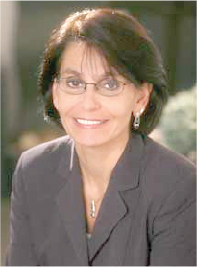MAKING THE SEASON BRIGHT Over 70 members of the Centerport Garden Club gathered at the Harborfields Public Library in Greenlawn before the holidays to make Christmas wreaths for the community. Handmade with evergreens from the members’ gardens, the completed wreaths adorned the local post office, library, town memorials and historic homes. Members also created holiday centerpieces for donation to local veteran’s homes.

Yearly Archives: 2017
Long Island Museum receives generous gift

The Long Island Museum in Stony Brook recently announced that its collections committee voted to approve the acquisition of an original oil painting by artist Jane Wilson, who passed away early in 2015. The painting, titled “Storm Light,” was completed in 1993 and is a gift of Wilson’s estate.
The LIM’s Director of Collections and Interpretation Joshua Ruff commented, “We are very happy to be one of a number of institutions that were chosen by Jane Wilson’s Estate to receive her work.” “Storm Light” is the fifth example of Wilson’s work to be added to The Long Island Museum’s permanent collection. The museum owns four additional Wilson paintings dating from 1955 to 2000. Other institutions that own her work include the Hirshhorn Museum, the Modern Museum of Art, the Smithsonian, and the Parrish Art Museum.
Jane Wilson, who was a part-time resident of eastern Long Island since 1960, was a talented painter who merged expressionism and realism, creating memorable landscapes known most for their dramatic horizons. After her passing early last year, she was the focus (along with fellow artist Jane Freilicher) of a major exhibition at the Parrish Art Museum. “Storm Light” will be highlighted as a new acquisition, on prominent display, when The LIM opens its new season on Feb. 24.
 WINTER HOURS FOR THE LIM: The Visitors Center of the The Long Island Museum, 1200 Route 25A, Stony Brook will be open from Jan. 5 to 29 from Thursday to Saturday from 10 a.m. to 5 p.m. and Sundays from noon to 5 p.m.; closed from Jan. 30 to Feb. 1. The Carriage Museum will be open from Feb. 2 to 18, Thursday to Sunday from noon to 5 p.m. and again on Feb. 23 from 11 a.m. to 5 p.m. The Art Museum is closed through Feb. 1. For further information, please call 631-751-0066 or visit www.longislandmuseum.org.
WINTER HOURS FOR THE LIM: The Visitors Center of the The Long Island Museum, 1200 Route 25A, Stony Brook will be open from Jan. 5 to 29 from Thursday to Saturday from 10 a.m. to 5 p.m. and Sundays from noon to 5 p.m.; closed from Jan. 30 to Feb. 1. The Carriage Museum will be open from Feb. 2 to 18, Thursday to Sunday from noon to 5 p.m. and again on Feb. 23 from 11 a.m. to 5 p.m. The Art Museum is closed through Feb. 1. For further information, please call 631-751-0066 or visit www.longislandmuseum.org.
Gardening: Where do those odd plant names come from?
By Ellen Barcel
Sometimes we just plunge into gardening and sometimes, especially if it snows outside, we’re staring at a beautiful fire in the fireplace and just pondering where do those odd plant names come from?
Marshmallow

Ever wonder where the word “marshmallow” comes from for the delightful candy we float in hot chocolate? Well, way back when, when the treat was first concocted in ancient Egypt, it was a mixture of honey (a sweetener) and the sap of the marshmallow plant (a thickener). Read the ingredients of marshmallows today and you’ll see they say basically sugar (the sweetener), water and gelatin (a thickener), then coated with cornstarch (to keep them from sticking together).
Marshmallow (Althaea officinalis) is a perennial plant found in Europe, Asia and North Africa and, as its name implies, grows in marshes. If you are interested in growing herbs, you can get the seeds online. The plant, which produces a light pink flower, grows to about three feet tall and needs a rich soil that holds moisture (remember it’s a marsh plant). It’s a perennial in U.S.D.A. zones 3 through 9 (Long Island is zone 7). You must be patient with this one as it doesn’t flower generally until the second year and may take even longer to have its roots large enough to harvest some.
Hellebores
Hellebores (Helleborus niger and H. orientalis) are early, herbaceous bloomers that come in a wide variety of colors from white through pinks and purples and even green. The cup-shaped flowers bend over (making it hard to photograph them, I know). Consider planting them in a raised bed so you can more easily enjoy the flowers.

Hellebores, also known as winter rose or Lenten rose, are not closely related to roses at all. They do well in U.S.D.A. hardiness zones 5 through 8. They’re very cold hardy — you can sometimes see them poking through late snows. However, check the variety you are planning to add to your garden as some are more cold tolerant than others.
But, where does the name hellebore come from? There’s folklore stating that the plant was used in old witchcraft to summon demons. But the name actually comes from the Greek meaning to harm food, as some varieties of hellebores are highly toxic, so I guess that is “hellish.” Other folklore, which relates to the name Christmas rose (H. niger), is that the tears of a young girl led the plant to bloom around Christmas as a gift to the Christ child.
Jacob’s ladder
Then there’s Jacob’s ladder (Polemonium caeruleum). The leaves rise along the stem, some seeing it like the biblical Jacob’s ladder to heaven in his dreams. According to Rutgers Extension, the plant is rarely bothered by deer, a plus on Long Island, but no plant is deer proof if they are hungry enough. It’s also somewhat drought tolerant, another plus, and shade tolerant. The bell-shaped flowers can be white, pink, blue or even yellow — take your pick.

Like hostas, Jacob’s ladder prefers a semi-shady to shady location since it is a small woodland plant. It can burn in strong sunlight. Make sure the soil is rich as a woodland’s might be. It prefers cooler weather and may need to be cut back in the heat of summer. P. reptans is a creeping Jacob’s ladder and native to North America.
I’ve read that cats really like Jacob’s ladder, as they like catnip, so if you have a lot of stray cats around you may need some form of protection for them, the plants that is, not the cats. An herbaceous perennial, it can be divided every few years. This is one where the seeds can still be planted in late autumn and will germinate the following spring.
Solomon’s seal
Solomon’s seal, (Polyonatum odoratum) also known as King Solomon’s seal is native to North America, does well in full or part shade and blooms May to June. The herbaceous perennial is in the asparagus family and a relative of lily of the valley.

As a woodland plant, it is relatively small, just a foot or two in height. In woodlands trees shed their leaves, which decay to form a rich compost, so keep this in mind when growing it in Long Island’s very sandy soil. Add compost to your shade planting bed (or let your leaves compost themselves under your trees in the shade). It does well in U.S.D.A. zones 5 through 9 and can be grown in more acidic soil than the others above, with a pH of 5.0 to 7.
Its scientific name refers to the “many knees” found on the underground rhizome. But where does the common name come from? Some noted the depressed spots on the underground roots and thought it looked like the royal king’s seal. Others thought a cross section of the stem resembled a Hebrew character.
Consider interspersing your Solomon’s seals with some nice, hardy ferns. Since they spread by the rhizomes as well as reseed themselves, you can develop a really nice bed. As they are somewhat slow growers, the seedlings will take a few years to bloom, but established beds can be divided in early spring.
The first three of the above plants do best in a soil pH near neutral (7) — only slightly acidic to a bit alkaline. Consider liming your soil if it is very acidic.
Ellen Barcel is a freelance writer and master gardener. To reach Cornell Cooperative Extension and its Master Gardener program, call 631-727-7850.
Cooking Cove: Dress up your bread pudding
By Barbara Beltrami
If ever there was a culinary invention that deserved the prize for simplicity, nutrition, versatility, economy and popularity, it’s got to be bread pudding. Take some leftover stale bread, throw in a couple of eggs, some milk, a little sugar and butter and vanilla and you basically have the foundation for not only a delicious dessert but a pretty wholesome breakfast! Dress it up by adding raisins, nuts, chocolate chips, chopped dried fruit, cinnamon or whatever your imagination dictates. For a quick and elegant dessert, top it with a stewed fruit compote, whipped cream, ice cream, vanilla, chocolate or whiskey sauce, liqueur or just about any combination. For breakfast, crank up the nutrition with that same stewed fruit compote, fresh fruit, yogurt, maple syrup, warm milk or a little dollop of jam. Again, the possibilities and combinations are practically endless, but my very favorites are the stewed fruit compote or just fresh fruit and whipped cream for dessert … or breakfast.
Basic Bread Pudding
YIELD: 4 to 6 servings
INGREDIENTS:
2 tablespoons butter, melted plus 1 tablespoon solid butter for greasing baking dish
2 cups milk
Dash of vanilla extract
½ cup sugar
Pinch of salt
3 eggs
5 to 6 cups day-old bread, cubed
DIRECTIONS: In a medium bowl, combine the melted butter, milk, vanilla, sugar, salt and eggs. Beat until well blended. Grease a 6- to 8-cup baking dish with the one tablespoon solid butter. Place the bread in the baking dish and pour liquid mixture over it. Cover, refrigerate and let sit until bread has soaked up all or most of the liquid. Preheat oven to 350 F. Uncover baking dish and bake 30 to 45 minutes until liquid is set and bread is golden. Serve warm or at room temperature. Refrigerate and reheat any unused portion.
Stewed Fruit Compote
INGREDIENTS:
4 cups fruit, pitted, pared, cored, as applicable
½ to 1 cup sugar, depending on sweetness of fruit
Dash of vanilla extract
One cinnamon stick
Peel of half an orange or lemon, pith removed
Red or white wine or apple juice to barely cover
DIRECTIONS: Combine all ingredients in non-reactive sauce pan. Cover and simmer over low heat until fruit is soft and liquid is somewhat reduced. Remove cinnamon stick and citrus peel. Let cool. Refrigerate, covered, until ready to use. Reheat and serve hot or warm over bread pudding. Top with whipped cream if desired.
Legally Speaking: Can a will’s executor take the money and run?
By Linda Toga
 THE FACTS: My father died recently. He had a will in which he named my brother as executor. My brother and I have not spoken to each other in a number of years. I am concerned that he will close out my father’s accounts and sell his house and keep all the money even though I am named as a half beneficiary under the will. He seems to be under the impression that since he is the named executor, he can do these things simply by presenting the will.
THE FACTS: My father died recently. He had a will in which he named my brother as executor. My brother and I have not spoken to each other in a number of years. I am concerned that he will close out my father’s accounts and sell his house and keep all the money even though I am named as a half beneficiary under the will. He seems to be under the impression that since he is the named executor, he can do these things simply by presenting the will.
QUESTION: Is that true?
THE ANSWER: Absolutely not! Although your brother is named in your father’s will as the executor of his estate, the surrogate’s court in the county in which your father resided at the time of his death must admit the will to probate and issue letters testamentary to your brother before he can take any action with respect to your father’s assets.
In other words, he must establish to the court’s satisfaction that the will is valid before he is able to act as executor. He cannot assume the responsibilities of executor without the court’s explicit approval. The complexity, cost and time involved in having a will admitted to probate will vary with the number of beneficiaries named in the will, as well as the number of heirs to the estate, the ease with which the attorney assisting the named executor can locate the beneficiaries and heirs, how cooperative those people may be with the attorney in moving forward, the value of the estate and whether anyone contests the admission of the will to probate, among other factors.
While the probate process can be straightforward and relatively inexpensive, there are numerous issues that can arise in the probate process that are best handled by an experienced estate attorney. Some of the most common issues with probate are not being able to locate individuals who are entitled to notice and dealing with individuals who contest the validity of the will. Fortunately, the percentage of cases where a will is contested and ultimately not admitted to probate is small. However, if there are objections filed to the probate of a will, the probate process can drag on for quite some time, significantly increasing the expenses of the estate.
If you and your brother are the only beneficiaries named in the will and your father’s only children, and you do not have a basis for contesting the will, the probate process should be relatively straightforward. Once the court issues letters testamentary to your brother, he can sell the house and close your father’s bank accounts. However, he cannot simply keep the money for himself since he has a legal obligation to carry out the wishes set forth in your father’s will.
In your case, he would be required to distribute to you assets valued at half of the value of the estate after accounting for your father’s legitimate debts, funeral and estate administration expenses, commissions and estate taxes. If you suspect that he has not done so, you should demand that he account for all of the estate assets so you can see the value of the marshaled assets and the expenses incurred by the estate. If you are not satisfied with the accounting he provides, or have reason to believe that he breached his fiduciary duty to you as a beneficiary, you can ask that his letters testamentary be revoked.
Since this process can get quite involved, if it comes to that, you should seek the advice of an attorney with expertise in the areas of estate administration and litigation.
Linda M. Toga, Esq. provides legal services in the areas of estate planning, probate and estate administration, real estate, small business service and litigation from her East Setauket office.
Photo of the Week
HAPPY NEW YEAR Nature photographer Jay Gammill of East Setauket captured this image of a red-tailed hawk eyeing his backyard feeder and its visitors on New Year’s Day. The bird of prey, knicknamed Big Red, has been a party crasher in the backyard for the past month.
Life Lines: Magic, religion and science

By Elof Axel Carlson
In 1890 Sir James George Frazer (1854-1941) wrote “The Golden Bough.” Frazer was Scottish, educated in Glasgow and then in Cambridge studying classical literature (Greek and Roman). He studied mythology, comparative religion and anthropology. His book argues that magic gave rise to religion and religion to science.
Magic assumes there are supernatural powers that some people can invoke or possess as innate gifts. With magic, what seems impossible can be made possible, at least to the observers of magical acts. Most professional magicians deny that they possess such gifts, and Houdini spent considerable time duplicating the tricks and illusions other magicians (and charlatans) used to deceive the public.
Frazer surmises the earliest humans believed in magical acts and associated them into rituals and myths with a belief in gods, often family ancestors, mythic heroes who were founders of a tribe, clan or larger population and sky gods. He believed the idea of resurrection came from the seasonal observation that plants die, scatter seeds and in the spring a resurrection occurs. He calls this “the dying corn god.”
Religion largely replaced magic as the basis for interpreting how the world arose, how society should function and how we relate to our gods. Religion in turn led to science with mathematics replacing numerology, astronomy coming out from astrology and chemistry from alchemy. The pursuit of knowledge from pseudoscience led to a weeding out of the failed experiments and predictions and a respect for more empirical and reason-based studies of the material, living and psychological universe in which we live.
Contemporary historians and philosophers differ with Frazer and among themselves on the origins of science. Some use a Marxist interpretation that farmers and workers laid the groundwork for science by their practical approaches to cultivate nature. Some argue that science is actually a cultural consensus or construction that shifts to new consensus and constructions in response to political and cultural changes.
Most scientists reject these social views of science and favor a material universe that can be explored, interpreted and manipulated with tools, experimentation, reason and data replacing myth, ideology or the supernatural. At issue in these debates are the ways scientists see the universe and their efforts to understand it. Science sometimes overthrows prevailing beliefs seen as truths. More often, it modifies its findings and its implications, incorporating the old as a portion of the new.
Newton’s laws of motion and gravity were not negated by Einstein’s theories of relativity or space-time. They became a more limited application useful for studying Earth and its solar system. Science is limited in what it can predict. We do not know if there are few, many or an unending number of scientific laws that may emerge in the centuries and millennia to come.
Elof Axel Carlson is a distinguished teaching professor emeritus in the Department of Biochemistry and Cell Biology at Stony Brook University.
Have you seen Wookie?

HELP BRING WOOKIE HOME! In the late evening of Nov. 11, 2016 there was a house fire on Minto Court off of North Howell Avenue in Centereach. The family and the family’s dogs escaped the fire. However, one of the dogs, Wookie, went missing after escaping the fire.
Wookie is a 10-year-old female shih tzu, beige in color. She is spayed and microchipped. This family has two small boys who desperately want their family to be complete again. The area is near Nicolls Road and Middle Country Road around the powerlines. No tip is too small.
Please call April at 631-278-4932 or join the Facebook group Finding Wookie.
Details on fiery Setauket golf course crash
Paul Rodier, the first assistant chief of the Setauket Fire Department, responded to the scene of a car accident Jan. 3 at St. George’s Golf Club on Lower Sheep Pasture Road in Setauket. What he found on arrival was much more than that.
“The original call stated ‘car accident,’” Rodier said. “A minute and a half later ‘car into building.’ Then, ‘car into building on fire’ and finally, ‘possibly a person trapped in the car.’”
According to Suffolk County police, 19-year-old Alyssa Chaikin lost control of her 2003 Jeep Liberty on wet pavement at about 5:40 p.m. She struck a wooden guardrail, went through a chain-link fence and down an embankment. The car crashed into a building on the golf course. The Jeep caught fire and the fire spread to the building, which houses a bathroom and is used for selling refreshments, and was destroyed.
Chaikin was able to crawl out of the vehicle and was assisted by another driver, Richard Glaser, who quickly ushered her away from the blaze to his vehicle, parked on the side of the road.
Upon his arrival at the scene, Rodier said the car and a third of the building were engulfed, and traffic was heavy on Sheep Pasture Road. An electric pole was also involved and may have been the cause of the fire.
“That female is very lucky to be alive. The call went from bad to worse. Thankfully, it ended well. That’s our main goal.”
— Paul Rodier
Rodier said he found a first responder and a medic with the ambulance. He was directed to the young woman, seated in the passenger seat of the good Samaritan’s car, where he assessed her condition. Finding her breathing, able to communicate and not requiring emergency measures at the scene, Chaikin, of Stony Brook, was transferred to the ambulance, and Rodier turned his attention to orchestrating the fire response.
Glaser, a manager of information technology at Stony Brook University Hospital, said he was driving by and pulled over to try to help. He said he did not see the accident happen.
“It feels really good that I was able to pay it forward and help someone out,” he said in an email. “I just hope that more people do the same when the opportunity happens.”
Stony Brook University Hospital was contacted to confirm if Chaiken was still a patient on Jan. 10, but no further information was available. Her parents could not be reached for comment.
Rodier said an investigation was ongoing to determine the cause of the accident and that he hoped news of the accident would cause other drivers to concentrate more on their driving and try harder to avoid distractions.
“This was a wake-up call to pay attention to your driving,” Rodier said. “We don’t know all the details. It should not have happened. That female is very lucky to be alive. The call went from bad to worse. Thankfully, it ended well. That’s our main goal.”
PSEG rate hike adds stress to seniors

Local seniors are getting the cold shoulder from PSEG Long Island electric rate increases, which have forced those on fixed incomes to make difficult and dangerous living decisions — and they’re not going to take it anymore.
Suffolk County Legislator Sarah Anker (D-Mount Sinai) led a protest against the rate hikes with vocal seniors from Leisure Village, Leisure Glen and Leisure Knoll at the Leisure Village clubhouse in Ridge Jan. 10.
Representatives from the senior communities gathered to voice their concerns that the recent revisions to the rates have been harmful and “debilitating” to them. Some residents, of which a large majority are in their 70s and 80s, have to debate whether or not to heat their homes and pay for food or heat their homes and pay for their prescription medications because they just can’t afford all three.

Carole Leonard, president of the board of directors at Leisure Village, said it’s “insane” seniors have to live this way.
“They’re absolutely freezing. They keep electric so low and some are still seeing [up to] $600-$700 electric bills each month,” she said. “There are residents who sit in their house with blankets on them because they’re cold and they’re afraid to turn the heat up because of the rates.”
Mike Elkins, a retired resident, has been reduced to turning the heat on in just one room in his condo.
“It’s really bad,” he said. “As you get older, you get more pains and aches and with [these bills], you just can’t make the house comfortable and affordable at the same time.”
The revisions from PSEG at the start of the new year have made rates higher than the originally announced $3.50 increase; so now the average customer using 775 kWh of energy in a month will see an increase of $7.57, or 5.4 percent, in their total energy bill. Customers who use 762 kWh will see their bills increase by $6.44. Because residents living in Leisure Village, Leisure Glen and Leisure Knoll rely on electricity for everything, even cooking, their use of kilowatt-hours in the winter is projected to double and even triple the average 775 projected by PSEG, which would bring their increases to $15-$22.
The LIPA bill also includes a decoupling charge and delivery service adjustment fees, all implemented in 2016 giving LIPA permission to recoup revenue that fluctuates due to weather, green energy and labor agreements. The energy costs hit seniors the hardest.
At the protest, Anker, with full support of the residents as well as AARP, pushed for the PSEG board to revisit the rate increases and consider the impact the hikes have on the overall senior population.
“As you get older, you get more pains and aches and with [these bills], you just can’t make the house comfortable and affordable at the same time.”
—Mike Elkins
The legislator also called for New York State to create an independent utility consumer advocate — a special department that will provide oversight and accountability and possibly challenge heightened rates and fees. There are only 10 states in the country that don’t have this department, and New York is one of them.
She said California saved consumers $4 billion since establishing its own advocate agency.
“Having the consumer advocate would level the playing field between the consumer and the utility companies and we’d be in better shape,” Anker said. “The most important thing we can do is communicate.”
Anker said she hopes the message reaches PSEG Long Island, the New York Public Service Commission, the New York Department of Public Service and Gov. Andrew Cuomo (D), who was speaking in Farmingville the same day calling for 30 miles of wind turbine farms in Montauk, as part of his initiative to have 50 percent renewable energy by 2030.
“How dare Gov. Cuomo,” said Leonard. “We’re gonna pay for something vacationers will have when we can’t, at this moment, pay for our food, medication and keep warm? Something has to be done. We need a senior advocate on the Public Service Commission who’s going to speak for us. We are tired of these rate heights pushed on us.”











